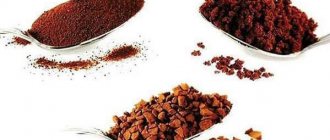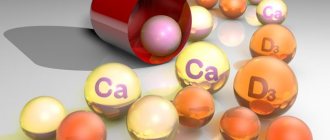Coffee is the most popular natural drink, which has a rich composition. It consists of numerous structural elements of organic and inorganic nature, affecting the human body in different ways. Freshly roasted coffee beans contain about a thousand different chemical compounds. So what does coffee contain and what effect does it have?
General information about the chemical composition
Coffee beans contain many biologically active components, but their concentration varies significantly depending on the method of preparing the raw material. These compounds are acidic or alkaline in nature depending on their structure.
Raw grains contain up to 12% liquid, about 8% sugary substances and the same amount of tannins. The share of fiber in fresh raw materials accounts for about a quarter of the dry residue. The alkaloid content in grains reaches 12%. Coffee beans necessarily contain fats, as well as proteins and carbohydrates in small quantities.
After roasting, coffee raw materials lose a significant amount of water, carbohydrates, and tannins. At the same time, the concentration of fats and alkaloids increases. Heat treatment promotes the storage of acids, vitamins and essential microelements.
Chemical composition of coffee
It's quite complicated. Coffee contains a huge number of different chemical compounds, and new ones are also added during the process of roasting coffee beans. The total number of different substances contained in coffee reaches several hundred. Roasted coffee contains about a thousand chemical compounds, of which eight hundred are responsible for its taste and smell. Of the extractive (excreted) substances that make up almost any type of coffee, we can note such groups as proteins, alkaloids, mono- and disucrose, phenolic compounds, lipids, amino acids, organic acids, mineral elements and some other chemical compounds that are contained in coffee in extremely small quantities.
Content of proteins, fats and carbohydrates
Coffee beans, in addition to a huge number of active substances and aromatic compounds, contain three main groups of components:
- squirrels
- fats
- carbohydrates
Their ratio depends on the type of coffee, the method of preparation and the growing conditions of the plant.
Squirrels
The content of protein compounds strongly depends on the species of a particular coffee crop. The dependence of the concentration of alkaloids on the number of proteins was revealed. During storage, their quantity does not change in any way, but a tendency towards an increase in the water-soluble fraction is noticed.
In addition to proteins, the group of nitrogenous compounds includes more than 20 free-type amino acids. Their quantity does not change in any way during storage. High-grade coffee contains a predominant amount of them in its composition.
Fats
In coffee beans, the concentration of oily compounds depends on the species. The minimum amount of fat is found in coffee grown in India. Coffee oil has the peculiarity of a large number of esters. Saturated fatty acids in the oil make up more than half. The content of linoleic acid predominates.
The qualitative composition of the oily component is identical for all coffee crops. With increasing storage time, a tendency to slow down oxidative processes has been observed.
Carbohydrates
Complex and simple sugars in coffee beans have a strong influence on the taste of the finished drink. They can serve as precursors for the formation of volatile structures obtained during roasting. These compounds give the drink a special aroma.
Carbohydrates in coffee are found in the form of glucose, fructose, galactose and sucrose, the concentration of which is about 30% of the water-soluble fraction. Each type of coffee contains a certain amount of sugars. During storage, their concentration does not change much.
The composition of coffee beans includes fiber, which occupies almost a third of the volume; it gives density to the grain. This property does not allow the raw material to be severely destroyed or boiled, increasing in volume. Fiber helps preserve the aromatic compounds that give the drink its special smell. This compound is quite stable; different types of coffee plants do not differ in its content.
Chemical composition of coffee - proteins and carbohydrates
As for proteins, there are not so many of them in coffee - a maximum of 9-10%, most of which is the so-called amine nitrogen (about 1.5%), that is, nitrogen that is part of the amino acids contained in coffee. There are much more carbohydrates in coffee: up to 50 and sometimes even up to 60% in raw coffee beans. Of the carbohydrates contained in coffee, the most are sucrose and cellulose - on average 8 and 8.5%, respectively. Also, lignin and fiber (so-called high molecular weight polysaccharides) and pectin carbohydrates are present in coffee in slightly smaller quantities. Of the high molecular weight polysaccharides, some have a high degree of solubility in water, and most notably arabinogalactan, a substance that is found in large quantities in various deciduous tree species. Arabinogalactan, by the way, has a beneficial effect on the intestinal microflora and helps protect the body's immune system. Also, substances such as mannose, galactose, arabinnose and glucogalactomannan are released from coffee beans during interaction with water. Fructose and glucose are also found in coffee in small quantities, although until recently it was believed that they were not there. Reducing saccharides - a group that includes fructose and glucose, depending on the type of coffee, are contained in quantities from 0.5 to 1%. Now let's talk about some of the most important substances in coffee, the composition of which, as you have already noticed, is incredibly complex.
Alkaloids
Coffee contains abundant amounts of alkaloids, but only some of them are capable of producing physiological effects. As the coffee bean matures, it accumulates two main alkaloids:
- caffeine
- theobromine
The first is stored in the shell of the product, the second in the inner part. If the drink is made from unprocessed whole grains, then both nitrogenous substances are present. Coffee alkaloids determine the tonic effect of the drink on the body.
Caffeine
This alkaloid is an important component of coffee. It is this that causes all the physiological effects caused by the tonic drink. In its pure form, this substance has no distinct odor or color, but it can be identified by its rather bitter taste. This substance has high solubility in polar liquids and a neutral reaction in the environment. In coffee, the alkaloid is found in monovariant or associated with sour potassium in salt-type compounds.
The concentration of the main nitrogenous compound determines the quality of coffee. Each type of this drink differs in its concentration of alkaloid. This is influenced by the natural conditions in which the raw materials were grown.
Caffeine is responsible for the main effect of the drink. This is primarily a stimulation of the nervous system. But with frequent use it can cause slowness in the conduction of nerve impulses. And in abundance it can provoke exhaustion of the body.
Theobromine
This nitrogenous compound, like caffeine, has a pronounced bitter taste. It differs from caffeine in its saturation with methyl groups. Theobromine is poorly soluble in aqueous media and occurs in the form of crystalline hydrate. This alkaloid is most often clear or white in color.
This substance acts almost like caffeine, but the effect is not as pronounced. Theobromine has a high affinity for the cardiovascular system. It has a positive effect on the functioning of the heart muscle, increasing its contractility and improving the functioning of the coronary arteries. The most pronounced effect is noticeable on the muscles involved in breathing. Theobromine also helps reduce blood pressure and reduce renal blood flow. For this reason, after taking a tonic drink, it is necessary to replenish your water balance.
How coffee changes your mind
Finally, a very interesting fact. Australian scientists from the University of Queensland have found that a person who has consumed a certain dose of caffeine is more easily susceptible to psychological influence .
This conclusion was made based on experiment. 140 volunteers took part in it. Each of the subjects was asked in advance about their position on a specific topic. They divided everyone into two groups: the first group was asked to drink several cups of coffee, while the second group was left without a drink.
Counter-arguments against the participants' positions were then provided. And the most interesting thing: those who did not drink the coffee drink did not change their opinion. Lovers of the strong drink were inclined to change their point of view , and some of them changed their minds after listening to the arguments.
Scientists characterize these actions by the fact that a person who drinks coffee experiences a kind of euphoria, and therefore is more relaxed in his behavior and judgment.
Next time at negotiations, I will probably refuse a cup of aromatic coffee. And I advise you 

( 10 votes, overall rating: 4.80 out of 5)











